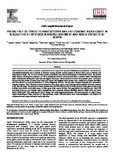Prevalence of cystic echinococcosis and its economic significance in slaughtered livestock in kisumu east/west and isiolo districts of Kenya

View/
Date
2015Author
Joseph Odero
Magambo J
Zeyhle E
Kutima H
Ndahi L
Njoroge F
Kern P
Romig T
Metadata
Show full item recordAbstract
Cystic Echinococcosis (CE) is a zoonosis caused by the larval stage of the tapeworm Echinococcus granulossus. The disease has a worldwide distribution and is endemic in livestock rearing, nomadic pastoral regions of Eastern Africa such as Turkana and Masaailand in Kenya. The life cycle involves canids as definitive hosts and livestock/human as intermediate hosts. The present study aimed at assessing the prevalence of CE in slaughtered livestock and associated direct economic impact resulting from organ condemnation during meat inspection and suggests sustainable control measures to reduce the economic losses. A five year retrospective data review of annual meat inspection reports and slaughter house surveys were conducted in Kisumu East/West and Isiolo districts to assess the prevalence of CE in slaughtered livestock. The data were analyzed using Ms excel spreadsheet computer program. Cystic Echinococcosis was found in cattle, sheep, goats, camels and pigs and the hydatid cysts were common in the liver and lungs. The prevalence’s were; Kisumu East and West districts cattle (4.24%), sheep (4.52%), goats (2.02%), pigs (0.05%), Isiolo district cattle (6%), sheep (1.33%), goats (1%), camels (25.3%). The pigs had the least infection rate. Direct CE associated losses per year through organ condemnation were estimated, Kisumu East/West districts (US$ 4,976) and Isiolo district (US$ 4,054). This study was the first in Kenya. The study suggested sustainable CE control measures to reduce losses, regular deworming of dogs, reduction of dog population, proper and professional meat inspection/hygiene and disposal of condemned animal organs and public health education.
